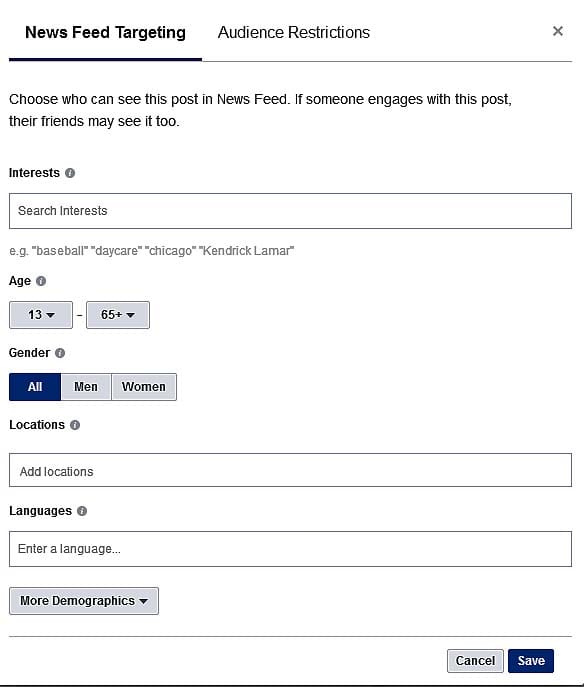A good SEO, a good Content Marketing and Social Media Marketing are the three pillars of Inbound Marketing. Working together and aligned, these three areas can provide excellent results.
Let’s focus on Social Media Marketing and 11 essential strategies for Social Media Success.
But first let me ask you a question: Do you think Social Media is a strategy or a marketing area? I suggest you to give your opinion in the comments section!
1. Social Media Marketing is not just about promotion or distribution:
Many people associate social networks with promotion or they see them only as content distribution channels.
Certainly, social networks are good for promoting your products, services, your business, brand or your website and distribute your content. Prospects are there.
With this only promotional view, many of people think “Ok, let’s create profiles and pages in as many social networks as possible to gain visibility. Everybody is there and, in addition, it is a free advertising way! It is like a school of fishes.”
But then they find that those social profiles and pages don’t work. Social Media is not that easy.
Those social profiles and pages don´t work because they are not updated or maybe they are fully automated. While automation is necessary to save time, not all publications types can depend on a machine. Think about real time publications like this:
Delta Airlines leveraged the Election Day in a very single and smart way
Red or blue states. We take you to them all. #Election2016 pic.twitter.com/AN0GuBRH98
— Delta (@Delta) November 8, 2016
Or maybe social profiles and pages don’t work because they are too self-promotional and they provide no value.
Updating and nurturing social networks requires a time investment that can provide a good quality and quantity ROI. But you have to work them.
Have you ever seen multiple profiles on social networks without any content or information? What did you think? What perception did you have about the brand, web or company?
You probably wondered: “Why they have created profiles on social networks if there is nothing?”
It is like having lots of blank billboards!

2. Choose the right social networks:
Each social network is different and each of them has its pros and cons. If you spend time watching and diving, you will find that their processes are different.
Twitter is a huge content machine that never stops. It is difficult for your tweets to get the desired impact. And a tweet life cycle is very short. In less than five seconds, hundreds of new tweets about your same topic or industry are generated.
Another factor to be considered is users’ behavior. To be honest, the truth is that we do not behave in the same way on Twitter, Facebook or LinkedIn, because the characteristics of each social network determine the nature and intention of our publications, what we share, what we publish, how we write and what we want to see in our timelines.
While Twitter is an ongoing and real time platform and publications are visible to everyone, Facebook is more private personal.
So, you should focus on the most appropriate social network for your business type, your goals and your target audience, and ask yourself:
- Where are my buyer personas?
- Where are my potential customers?
- Who I am marketing to?
For example: If you provide enterprise software and you want to build brand awareness and make valuable connections that may become future leads, your buyer personas are probably on LinkedIn and Twitter.
Instead, if you have an online fashion store, you should understand that your potential customers want and need to preview your products. Keep in mind that, depending on the product or service, making an online purchase is like taking a chance. So, it is very important to show as many pictures and information as possible.
And, where are your potential customers in this case? Probably they visit Facebook, Instagram and Pinterest.
Do you want to build a community of loyal customers? Facebook is the right place.
3. Social Media marketing is marketing:
Like any other marketing area, good Social Media requires a marketing plan, strategies and tactics or actions, KPI’s, analysis, monitoring… it is usually included in your content marketing plan or inbound marketing plan although some marketers create a separated social media marketing plan.
Whether you invest on social ads or not, you want to know if your strategies are working and get quantitative and qualitative metrics that help you reinforce certain strategies or introduce new ones: Conversions, interactions, comments, retweets, shares, new fans or followers, impact of publications…
There are many metrics to consider but it all depends on the role of social networks in your online marketing.
And, believe me. There are numerous possibilities to invigorate your social media success. There is a massive misconception about social media strategies. Many marketers think that strategies are costly and amazing campaigns that only big brands can afford.
Well, strategies are not campaigns. Strategies are an ongoing process, while campaigns are temporary actions.
You don’t need a huge investment and you don’t have to be Starbucks to success in Social Media.
……………………………………………………………………………………
Trick: Do you want people to stay tuned about your Twitter updates?
Invite them to turn on mobile notifications, including visuals, like a little “How to”. You can write a post about these Twitter features or place a banner in your blog/website.
This way, you are also educating your users, readers or customers, since many people don’t know all Twitter features. And if you educate your readers or customers you are providing value.
And the same goes for Facebook:
This is a simple strategy. You invite your customers or readers to subscribe to your newsletter right? Then, why don’t invite them also to subscribe to your social networks or prioritize your Facebook page updates in their news feed?
4. Publish on social networks with a purpose:
Well, to be true every time we publish on social networks we all have the same final goals: Get visits, clicks, sell…
Purposes are not goals. Purposes are more detailed, they are the way to achieve goals and they can help you to create the right publications types and formats and resonate with your potential customers and customers.
Purposes in Social Media are like Content Marketing. Depending on your target audience/s, your buyer’s journey stage, buyer personas, prospects, leads or your brand DNA, you may write an educational post to guide potential buyers from awareness stage to consideration stage.
On social networks, purposes are aligned with your content marketing strategies and actions, distributing and amplifying it.
They also have their own role: Increase brand awareness and help to strengthen customers engagement.
5. Social Media networks are touchpoints:
People who success in Social Media have clear that their social networks profiles or pages are touchpoints and they care about them, providing specific content, sharing others’ publications, being active and proactive, building and maintaining good relationships with their prospects and customers and providing solutions.
As you know, touchpoints (Or Touch Points) are essential during buyer’s journey, specially on social networks. Customers can cut ties with brands if their experience with them is disappointing. And this is a cost for that brand, which is added to the new customer acquisition costs.
6. Customize and enhance your publications:
Since each social network is different, their users’ behavior is different too. And hence, your audience’s behavior is different too.
You cannot distribute the same publication type in every social profile because something that works on Facebook may not work well in Twitter.
Think about what to publish on social networks as a user. What do you share? What type of publications call your attention? What kind of publications do you expect from a brand or company whose products you buy or whose services you hire? What do you expect from those brands or companies in social networks?
7. Be active:
Being active in social networks does not only mean to publish and publish. It also means being interactive and proactive. In fact, social networks were created for this purpose!
Interaction is the foundation of social networks. Without users interaction and users generated content, social networks wouldn’t exist.
An infographic from Abaya showed that 56 % of customers who use social media to interact with an organization say they feel a stronger connection.
You can publish opinions, make questions, encourage your followers interaction and engagement making questions or creating surveys, ask for opinions, talk about a trending topic that is relevant for your industry, share others’ content, initiate a conversation, join a conversation, share behind the scenes pictures and most important: Answer your followers and fans.
8. Listen and answer:
As a customer, you want a personalized treatment, right? Well, then put in your customers shoes and think about how you answer their questions and how you differentiate each single request.
Are you giving a standardized response to all your customers equally or do you really care about your followers?
We are not talking about privileges, but rather about being aware of your customers’ different needs and wants. You cannot answer a pre-sales question in the same way that you try to provide a solution or answer a complaint from a customer that spent 200$ and didn’t have a good shopping experience.
Keep in mind that today, users see social networks as a warmer and more direct way to interact and keep in touch with brands or businesses. Traditional forms are cold. Users don’t know if they will be answered and many times they must provide too much personal information.
According to the same research above mentioned, 50% of users are more likely to buy products or services from a company that they can contact via social media.
Unlike traditional forms, social networks are interactive and direct. And users (they, you, and I) hope to be listened… But the naked truth is very different…
According to The Sprout Social index 2015:
- 7 out of 8 messages through social networks do not get answers in 72 hours.
- Of all the messages sent, 4 out of 10 need a response from the brand. Users don’t just mention them, they want to be answered and interact through the social networks.
Facebook tried to solve this, adding new features to Facebook Pages, like the answers-time indicator. Once more, we talk about perception!
9. Segment your audience:
A good way to personalize and differentiate your customers is segmenting them. Segmentation is good for:
- Personalize your publications and make them visible for different targets.
- Social listening.
- Benchmark.
- Organize your followers into customers, potential customers, loyal customers… whatever you want.
- Organize the users you follow.
On Twitter you can build lists. On Facebook pages segmentation options are more sophisticated and accurate. Even, there is an option to decide specific audiences for each post.
Trick: How to publish targeted posts in your Facebook Page
- Go to your Facebook Page.
- Click ‘Settings’ >>‘General’.
- Find ‘Audience Optimization for Posts’ and click ‘Edit.’.
- Check the box to begin using this feature.
- Then, click on the circle when you want to publish audience targeted posts.
Audience targeted posts make them more relevant in people’s news feeds. This means that in your fans news feeds, your Facebook Page updates will have preference.
In addition, you can also classify your fans like on Twitter. But we will talk about it in our 50 Facebook Strategies post. Stay tuned!
10. Optimize your social profiles or pages.
Comprehensive information is the way to better connect with your followers, humanize your social presence and build trust. People want to know about brands and enterprises. It is usually said that people like to buy from to people, and it is true!
Some social networks (like Twitter or Instagram) don’t provide options to include information, but Facebook, LinkedIn or Pinterest do.
For example, Facebook information options are a great way for storytelling. You can talk about your mission, values, your brand or business’s history and many other data that your followers consider valuable.
Look at this Facebook Page long description:

They are telling their story, being humans. Buyers can identify with them and with the problem that led them to find a solution. Also, the value proposition is clear.
Other factors to optimize your social presence are obvious: Logo, an appealing cover, including pictures and calls to action, provide contact data (URL, phone, address, email).
11. Be aware of updates in social networks:
In the last two years social networks are changing very quickly to improve users experience and to adapt to social consumption trends.
If you are a time away from social networks, it is very likely that in your new visit you find new options or changes.
For example, following the rise of Snapchat or Periscope, major social networks were quick to implement real-time content, moments, live broadcast, perishable content, video upload enhancements, image filters or segmentation options, among other features.
Far from being obstacles, all these new options are opportunities to implement creative strategies, find more ways to resonate with your customers or users and stand out from your competitors.
Regardless the social networks you focus on, there are common essential strategies. No matter what social network/s you choose and you don’t have to make a great investment nor surprise your fans and followers with impressive cutting-edge strategies. All social networks, with their differences, have a common denominator: Users want to connect and interact with you and they expect you to take them into account.
What would you include in these strategies for Social Media Success?
Ready for 50 content ideas/strategies on Facebook, 50 on Twitter and more networks? Stay tuned!









Reading your site is pure pleasure for me, it deserves to go viral, you need some
initial traffic only.
Thank you Esther for your comment.